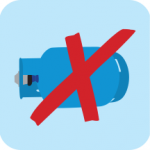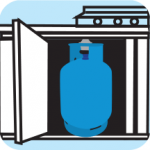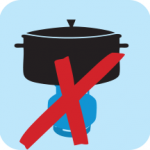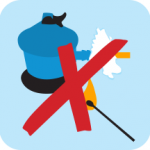Liquified petroleum gas (LPG) is the mixture of propane, propylene, butane, isobutane and their hydrocarbon mixtures. LPG that is brought into use in our country consists of 70% butane and 30% propane. LPG is in gaseous state at room temperature and atmospheric pressure, while it becomes liquid after applying pressure. LPG which is handled, stored and measured in liquid state is evaporated after being unpressurized and obtaining heat from the its environment and consumed in gaseous state.
LPG can be obtained from two main sources, natural gas wells and crued oil refinaries. When it is obtained from crued oil distillation, its sulphur content is reduced in order to comly with the standards. LPG that is in fact odorless is offered for consumption after aromatised with ethyl mercaptan in order to be easily identified in case of a gas leakage.
There are three main usage areas:
- Residential or commercial use of steel cylinders,
- In vehicles as a type of fuel,
- At industrial facilities and houses as bulk tanks.
Bulk tanks are mainly used in houses and tourism for heating purposes, on cookers, gas heaters and central heating systems for cooking and vapor generation and hot water supply. Beside of this, LPG has a wide usage areas as it is also used in textile industry for drying and ironing, in metal industry for pre-heating and metal melting, in dairy farms, in bakeries, in agriculture and animal husbandary and many other industries.
- Surrounding of the tank should not be covered by any means. Otherwise, gas may accumulate due to gas leakage.
- In order to prevent accumulation as a result of gas leakage surrounding the tank, there should not be any wells, holes, drainages and canals around.
- Any sparkle generating behaviour (match or lighter, switch on off) should be avoided as the gas leakage detected.
- After opening the doors and windows, LPG should be swept away as it is heavier than the air.
- In case of low gas leakage, the leakage point may be detected by using foamy water mixture and air bubbles.
- If the gas leakage is on the consumption device, gas valve should be shut and the area should be ventilated.
- In case that the gas leakage is on the installation in any building, the valve which is placed at building service box should be shut.
- In case that the gas leakage is in the building, gas outlet valve on the tank should be shut. You should immediately notify Intergaz upon taking all measures above.

Fire
- There is a risk of fire in case LPG is mixed with air in a specific amount and contacts a sparkle. For extinguishing such a fire, one of the factors should be eliminated. For instance, either the sparkle may be prevented, LPG flow may be cut or the ambience may be deoxygenated.
- In any fire outbreak, gas leakage should be blocked by switching the main valve off in the area. You should bear in mind that your arms and hands should be covered with wet towels while intervening the valve.
- Following that, obviously, the fire should be neutralised by using fire extinguishers.
If the flames are very close to the tank or the hoses, the tank should be cooled down by spraying water in order to prevent overheating. - In case that the fire outbreak can not be controlled, 199 fire report line should be notified as soon as possible, stating that the fireoutbreak was due to LPG.
- After the necessary fire fighting interventions, Intergaz Technical Support should also be notified in order to investigate the reason of the fire and, if necessary, recover damage in the system.
Safety Measures

Steel cylinders should not be used in the areas where people sleep, in particular bedrooms.

Steel cylinders should be kept and used in upright position, and should not be shaken or tilt.

Hoses to be used in your installations should be in compliance with TSE1846, as the length should not exceed 150cm and nozzles should be firmly attached to the loaf and device. Hoses should be renewed every 3 years at the latest.
Measures to be taken in case of gas leakage
- Gas cylinders should be shut by turning the valve (the loaf) off.
- No fire, no contact with any switch.
- No contact with sparkle generators such as telephones, refrigerators and bells.
- The area should be ventilated, and the gas should be swept away with a broom (being heavier than air, gas will be accumulated on the ground).
- Any persons should be evacuated from the area where there is a gas leakage.
- Catalytically used areas should be ventilated frequently.
- Keeping empty and full steel cylinders in an indoor area is dangerous.
Medical First Aid Rules
There are three main effects on human health of any incidents due to LPG use:
Inhalation:
Description:
Exposure to high level of LPG that contains no toxic substances may cause the central nervous system to collapse (when the oxygen level decreases under 18% and long term exposure) and even death by showing symptoms of sleepiness, headache, blurred vision, irritation of eyes, nose and respiratory system as a result of oxygen deficiency.
First Aid:
Exposed person should be moved to fresh air, enabled to breathe oxygen immediately, kept warm and calm, and taken to the hospital. In case that the exposed person can not breathe, mouth-to-mouth resuscitation and cardiopulmonary resuscitation should be applied and the victim should immediately be taken to the hospital for receiving medical aid.
Liquid burn (Cold burn):
Description:
LPG in liquid state would start evaporating as soon as it absorbs heat energy at atmospheric pressure level. Therefore, in case that LPG in liquid state contacts skin, it would try to obtain the heat energy from the body, so that the skin in that particular area would decrease in temperature and liquid burn (cold burn) would take place. As the LPG in liquid state contacts water or a humid material, it absorbs heat energy of the water and freezes it.
First aid:
Any clothes contaminated with LPG in liquid state should be taken off carefully. In case that the contaminated clothes freeze and stink on the skin, some water should be poured on it before taking it off. The liqulid burnt skin should be washed with plenty of water. NO HOT WATER USE AT ALL TIMES. The victim should immediately be taken to the hospital for receiving medical aid.
In case of any eye contact, the eyes, keeping the lids open, should be washed with water water not less than 15 minutes and the victim shoul be taken to the hospital as soon as possible.
LPG Fire Burns:
First Degree Burn:
Description:
Light redness on the skin, popilloma and dull ache.
First Aid:
Burnt skin should be washed with cool water or sink into water, it should not be in contact with any wet clothe until the pain wears off.
Second Degree Burn:
Description:
Blister on the skin, redness and strong pain.
First Aid:
Burnt skin should be washed with some water or sink into a bowl filled with water, than it should be covered with wet clothes. After few minutes, the burnt skin should be dried off (no rubbing, otherwise the blisters on the skin would be irriated and open to any infections). The wound should be covered with a sterilezed and dry bandage. If the burnt area is on the legs or arms, the organ should be held higher than the heart level. The second degree burns are usually healed within few weeks.
Third Degree Burns:
Description:
It is identified by its color, blanched or coal black.
First Aid:
No clothes should be taken off the burnt skin, that must be washed with some cool water. No cream application. The burnt area of the skin should be covered by clean and dry (clean sheets) clothes. If the burnt area is on the legs or arms, the organ should be held higher than the heart level. If there is any facial wound, the victim’s repiration should be checked frequently in order to identify any difficulties in breathing. Then, the victim should be immediately taken to the hospital.






